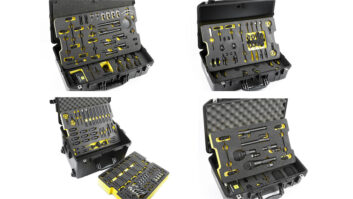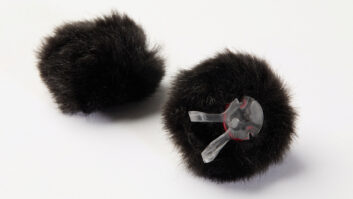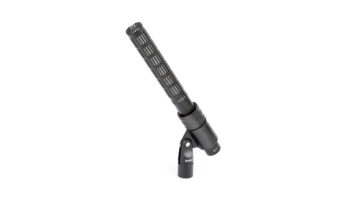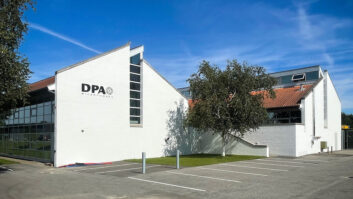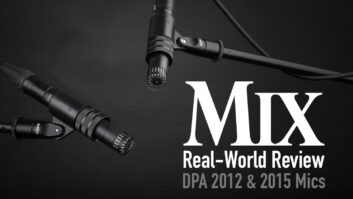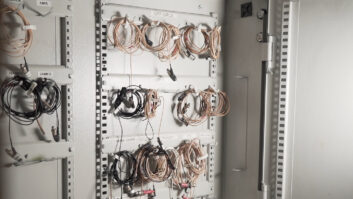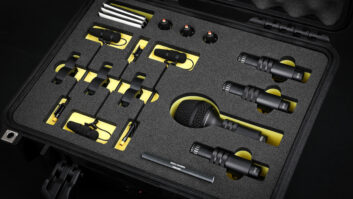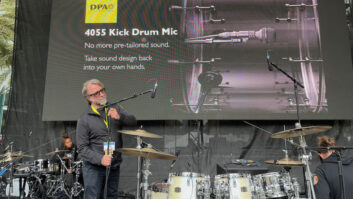The DPA Microphones 3532-T stereo microphone kit is a great
introduction to recording with spaced-pair, omnidirectional microphones. Packaged in a
spill-proof, foam-lined Sam-sonite attaché, the kit includes two
omnidirectional DPA 4041-T mics with MMP-4000-T tube preamplifiers, the
HMA4000 high-voltage mic amplifier/power supply, a UA0836 stereo boom
bracket, mic holders, windscreens and cables. The kit is also available
as the 3532-S, with 4041-S solid-state mics and packed with the same
capsules but with the MMP4000-S discrete, solid-state preamps. Extra
slots in the carrying case are provided for adding these FET
preamps—they are interchangeable and are also powered by the
HMA4000.
Danish Pro Audio was set up 10 years ago by former B&K
(Brüel & Kjaer) employees, and since February ’98, all B&K
microphones are branded as DPA and built with the same dedication to
wide bandwidth, dynamic range and high sonic quality as B&K’s
audio measurement gear. With 24/96 (and higher) resolution digital fast
becoming the standard, engineers and producers are becoming
increasingly concerned with dynamic range, low distortion, frequency
bandwidth and the wide-band phase integrity of the entire
recording/mixing chain—all starting with the microphone.
THE TYPE 4041-T MIC
The 4041-T microphone uses similar technology as DPA’s flagship 4040
Special-Edition Hybrid Microphone. Only 100 of these $10,000 glass and
metal-cased microphones were made using the MMC4041 capsule and a
cylindrical body that contains both tube and solid-state preamps. The
MMC4041 capsule is housed in a stainless-steel shell for environmental
protection and is one inch in diameter. The 2-micron-thick diaphragm is
also stainless steel. With its larger capsule end, the 4041-T resembles
a small flashlight because the black, anodized, tubular preamp body is
smaller, with a ¾-inch diameter and 6.7-inch length.
The mic’s 200-volt capsule polarization allows for a higher capsule
sensitivity at 90 mV/PA and a higher SPL rating due to the greater
diaphragm-to-back plate distance, which allows larger diaphragm
excursions before “bottoming out.” The mic’s SPL is rated
at 144dB SPL before clip; the dynamic range is 113
dB.
The mic’s MMP4000-T tube preamp body runs warm to the touch and
requires 130 volts for the 7599 miniature pentode running at unity gain
as a Class-A cathode follower. The 3532-T kits are delivered with both
mics matched within 1 dB for frequency response, sensitivity and
self-noise. The total phase response difference from 50 to 20k Hz is
just 10°. Frequency range is 10 to 20k Hz, with a smooth 4 to 6dB
lift centered around 8 kHz.
HMA4000
All voltages are provided by the 2-channel HMA4000 mic amp/power supply
over 10-meter cables using 6-pin XLRs. The HMA4000 is also the mic’s output amp,
because these mics put out line-level. There’s no need for mic preamps,
and these balanced line-level outputs eliminate many mic preamp
issues—such as noise, distortion and limited dynamic
range—not to mention cost. Buyers should remember these built-in
mic preamps when considering the $8,000 MSRP.
For each mic, the HMA4000 provides an XLR output connector and a
three-position gain switch for a choice of -20dB, 0dB or +20dB
operating levels. The mic’s standard output reference level is 0 dB,
not the “+4dB/0dB” studio reference level. It is also best
to start with a 0dB position when you are first setting up the mic.
Able to drive lines up to 300 meters, the HMA4000 uses Analog Devices
op amps for input stages and electronically balanced, transformerless,
Class-A line output drivers using only a single high-quality,
polycarbonate capacitor in the signal path.
Connecting mics into line inputs is a whole new ball game of gain
structure for me. Your console should have a line trim pot. Because the
three switch positions are a little too coarse to “dial-in”
superexact recording levels, a rotary wafer switch with finer 5dB
increments from -20 dB to +30 dB seems like a good modification for the
HMA4000. I also suggest a power-on/off switch, as cables must be
connected before plugging in the AC cable.
IN THE STUDIO
My first session with the mics was a drum kit overdub at Noise Club
Studios with songwriter/producer Oliver Leiber playing his vintage
Gretsch kit. We were using a Pro Tools Mix Plus rig, and I just plugged
the mic cables right into Leiber’s Apogee AD8000 I/O for a minimum
signal path.
I recorded drum room tracks about 10 feet in front of the kit,
spacing the mics about 10 feet apart. The room is small and
wood-paneled, and room mics help to take “boxiness” out of
the overall sound. Using omnis when overdubbing is best—they just
sound more like what you hear in the room. These room tracks turned out
to be the best I have ever recorded (given the room’s size), with huge
dynamics, a more diffuse sound and no noise at all. The top lift of the
mics was just the right amount so that cymbals didn’t get overly
loud.
For drum miking, I put the mics on the UA0836 stereo boom bracket.
This is a black, anodized aluminum bar that screws on a single mic
stand and rigidly holds both mics. The mics can be adjusted and then
fixed anywhere across the bar according to a calibrated scale. Each mic
can be individually aimed and locked down using the recticle markings
on swivel mounts. This precision makes it easy to recall the exact
distances and aiming angles later.
Standing three feet in front of the drum kit, I had both mics on the
“11” markings (9.5 inches apart) and aimed slightly
outward, with the left mic looking toward the floor tom side and the
right mic looking right toward the hi-hat side. The center of the bar
was directly in-line with the kick drum, about five feet off the floor.
Omnidirectional mics do have an on-axis point for higher frequencies,
so, in that sense, they are slightly directional. When I soloed the
DPAs, I could hear each physical position of each drum in a natural
way, as though I were standing right where those mics were. I did use a
mic on the kick to get more low-end boom and another for the snare, but
the majority of the drum sound was captured by the two unequalized,
uncompressed 4041-Ts.
Next, I recorded producer/artist Greg Mathieson playing his Yamaha
C7 grand at L.A.FX Studios. I used the stereo bracket with the mics
about 12 inches apart, positioned looking at the harp from midway down
the piano’s right side, with the left mic aimed toward the hammers and
the right mic at the far end of the harp. With the lid fully opened,
the mics were halfway between the piano’s edge and the underside of the
lid. One word: Fabulous! I had the HMA4000 set to 0dB gain and had
instant, full peak recording levels when Mathieson played his hardest.
The sound was high-resolution and clear—full, not overly
bright—and you could hear everything, including the room’s
anomalies, even though the mics were three feet from the strings.
GEE-TARS!
Next stop was Hollywood’s Icon Recording for close-miked acoustic and
electric guitars. Comparing and using omni condensers for electric
guitars to the immediacy and midrange character cardioid dynamic
microphones is like comparing “apples and oranges.” There
is no proximity effect, none of the inherent dynamic mic compression and exact positioning is
less critical. This mic offers a new sound choice to producers who
layer many electric guitar overdubs.
I liked the mics for loud and clean/crunch rhythm guitar parts where
sometimes dynamic mics (and preamps) compress too much for a clear
sound. For heavily distorted guitar sounds, the mic holds up well and
is able to take the level, although a lot of the subtleties the 4041-T
captures are lost amid the compressed and distorted guitar sound
itself. Suffice it to say, the 4041-T captures the sound of the whole
guitar amp better than a dynamic aimed at an individual cabinet
speaker. I began with the mics two inches from the grille and then four
feet away. The mics performed flawlessly, with no complaints or
overloading, and gave me a full, rich sound that was vastly different
from what is typical with dynamic mics. It sounds like you are standing
in front of the amp.
Recording acoustic guitars is natural for the 4041-T. I switched the
HMA4000 over to a +20dB output level, and I was set to go. I liked the
way the mic didn’t hype the high frequencies, leaving that choice to me
with EQ. For fingerpicking or nuance/soft playing, this is definitely
the mic to use. The sound was clear and showed exceptional detail. The
4041-T didn’t blow up (distort) with loud, open E-string thumbing from
the Martin D-16 I was recording, and even at one inch away, there was
no bass buildup. I used both mics spaced about six inches apart, and at
a distance of 18 inches, I got a stunning sound without EQ or
compression!
At $8,000, the 3532-T stereo microphone kit is a long-term
investment in great sound. These are the first microphones I have ever
used that were fantastic for any recording task, from room tracks to
drums, piano and acoustic or electric guitars. You can also buy a
single 4041-T with HMA4000 for $4,195.
SECOND OPINION
Engineer/Producer Bruce Botnick Takes the Type 4041-T and 3532-T Stereo
Kit for a Test Drive
I use a wide palette of mics for their color, clarity and imaging.
My favorites are the classic tube models: the Neumann M50, Sony C37 and
AKG C-12. I recently had the chance to listen to DPA’s 3532-T tube mic
stereo kit under battle conditions.
For this test, I used a matched pair of 4041-Ts in the 3532-T Kit in
various configurations for a motion picture score that I recorded with
David Newman at the Fox/Newman scoring stage in L.A. First, I mounted
the two mics about 20 feet apart and 12 feet over the percussion
section. Next, I used the mics as overalls on a trap drum set. The
third test involved hanging the 4041-Ts on multibrackets in a Decca
Tree configuration along with my classic Neumann M50s. Lastly, I used
the 4041-Ts as my main mics for recording a vocal chorus in some very
dead (and sonically unfriendly) rooms.
Overall, the DPA 4041-Ts are wonderful. In comparison to my M50s,
they exhibited excellent imaging and reach—the ability to hear
sonic details coming from all the way back in a room—to hear the
room’s reverberation. With transistor microphones,
“openness” and “reach” are not in the
vocabulary. Switching back and forth between the 4041-Ts and the M50s,
I found the differences slight when listening to a click track coming
from an open pair of earphones. The 3-D image in the room, even in
mono, was excellent. The sound isn’t flat or boring. It is open, smooth
and beautiful. Above the percussion section with timpani, shakers,
vibes, marimba and grand cassa (bass drum), the DPAs had great dynamic
range and could deliver an explosion of percussion with plenty of
headroom to spare. Indicative of a great tube omni mic, the 4041-T’s
bottom end goes cleanly through the floor while its high end is silky
and musical. When applying shelving or peaking EQ, the mics responded
well, without unflattering ringing or peaking. With a great equalizer,
the sound just opens up even more.
Over the drum set, I found the same results as over the percussion
section, except that, now, the mics were only two feet over the drums.
When the drummer played loud, they didn’t fold, and during softer
playing, all detail and sounds were picked up beautifully.
I still have more testing to find out how they respond to individual
acoustic and electronic instruments, but for now, I know the DPA 3532-T
Stereo Kit has a home as a new color on my palette of acoustical
paints.
DPA Microphones, www.dpamicrophones.com
